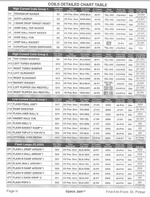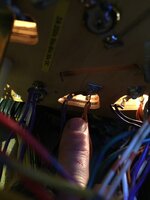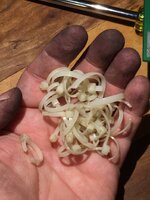so i'm still working with Space Jam and have made my list of what needs fixed, and am stuck - one coil and 4 flashers are out, so i'm wondering if there's a common link:
the problem i noticed initially was was a coil wouldn't fire in game or in test mode - coil #4 'jump ball top kicker', a 50V coil. the coil wrapper looked toasty with a stuck sleeve and the driver trans/mosf/whatever also looked a bit manky, so i replaced both coil/sleeve and driver at Q4. it still doesn't fire. i said i was also having trouble with some flashers - i replaced the bulbs but these ones all appear to be missing a drive signal or earth return - i was planning on replacing the TIP102s at Q21, Q22, Q23, Q26 and Q32 but maybe you fellas can point me in a better direction instead.
pic to break up text here - it serves no other purpose

for good measure i also replaced 4 IDC connectors with molex crimp-pin connectors, and this is when i realised that my game appears to be missing a wire from J10 pin 10, empty on my game but in the (crappy scan) manual on page 101 it says that there should be a yellow/black 24V AC output wire attached there. and it's not like yellow/black is a unique colour either, as i see three of these coming up in the looms - on the left, a yellow/black going to J13 pin 6 (for the lamp matrix), and on the right a yellow/black going to J11 (transformer AC input), and a yellow/black to CN4 on the CPU board (for something or other). so wtf is going on, is my game missing a wire to J10pin10 or not? Manual errors do happen.
and is there a common element that could be responsible for my troubled drivers at Q4, Q21, Q22, Q23, Q26 and Q32?
link to manual with ropey scanning: http://mirror2.ipdb.org/files/3879/Sega_1996_Space_Jam_Manual_Includes_Schematics.pdf
thanks fellas
@aaronhicksuk @lukewells @Jay Walker @Moonraker @pinballmania
the problem i noticed initially was was a coil wouldn't fire in game or in test mode - coil #4 'jump ball top kicker', a 50V coil. the coil wrapper looked toasty with a stuck sleeve and the driver trans/mosf/whatever also looked a bit manky, so i replaced both coil/sleeve and driver at Q4. it still doesn't fire. i said i was also having trouble with some flashers - i replaced the bulbs but these ones all appear to be missing a drive signal or earth return - i was planning on replacing the TIP102s at Q21, Q22, Q23, Q26 and Q32 but maybe you fellas can point me in a better direction instead.
pic to break up text here - it serves no other purpose

for good measure i also replaced 4 IDC connectors with molex crimp-pin connectors, and this is when i realised that my game appears to be missing a wire from J10 pin 10, empty on my game but in the (crappy scan) manual on page 101 it says that there should be a yellow/black 24V AC output wire attached there. and it's not like yellow/black is a unique colour either, as i see three of these coming up in the looms - on the left, a yellow/black going to J13 pin 6 (for the lamp matrix), and on the right a yellow/black going to J11 (transformer AC input), and a yellow/black to CN4 on the CPU board (for something or other). so wtf is going on, is my game missing a wire to J10pin10 or not? Manual errors do happen.
and is there a common element that could be responsible for my troubled drivers at Q4, Q21, Q22, Q23, Q26 and Q32?
link to manual with ropey scanning: http://mirror2.ipdb.org/files/3879/Sega_1996_Space_Jam_Manual_Includes_Schematics.pdf
thanks fellas
@aaronhicksuk @lukewells @Jay Walker @Moonraker @pinballmania
Last edited:




